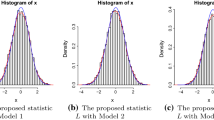Abstract
In this paper the authors study the problem of testing the hypothesis of a doubly exchangeable covariance matrix for three-level multivariate observations, taken on m variables over u sites and over v time/space points. Through the decomposition of the main hypothesis into a set of three sub-hypotheses, the likelihood ratio test statistic is defined, its exact moments are determined, and its exact distribution is studied. Because this distribution is very much intricate, a very precise near-exact distribution is developed. Numerical studies conducted to evaluate the closeness between this near-exact distribution and the exact distribution show the very good performance of this approximation even for very small sample sizes. A simulation study is also conducted and two real-data examples are presented.


Similar content being viewed by others
References
Anderson TW (2003) An Introduction to multivariate statistical analysis, 3rd edn. Wiley, Hoboken
Box GEP (1949) A general distribution theory for a class of likelihood criteria. Biometrika 36:317–346
Cardeño L, Nagar DK (2001) Testing block sphericity of a covariance matrix. Divulg Mat 9:25–34
Coelho CA (1998) The generalized integer gamma distribution—a basis for distributions in multivariate stastistics. J Multivar Anal 64:86–102
Coelho CA (2004) The generalized near-integer gamma distribution: a basis for ‘near-exact’ approximations to the distributions of statistics which are the product of an odd number of independent Beta random variables. J Multivar Anal 89:191–218
Coelho CA, Arnold BC, Marques FJ (2010) Near-exact distributions for certain likelihood ratio test statistics. J Stat Theory Pract 4:711–725
Coelho CA, Marques FJ (2012) Near-exact distributions for the likelihood ratio test statistic to test equality of several variance-covariance matrices in elliptically contoured distributions. Comput Statist 27:627–659
Coelho CA, Marques FJ (2013) The multi-sample block-scalar sphericity test—exact and near-exact distributions for its likelihood ratio test statistic. Commun Statist Theory Methods 42:1153–1175
Coelho CA, Roy A (2017) Testing the hypothesis of a block compound symmetric covariance matrix for elliptically contoured distributions. Test 26:308–330
Johnson RA, Wichern DW (2007) Applied multivariate statistical analysis, 6th edn. Prentice Hall, Upper Saddle River
Leiva R, Roy A (2011) Linear discrimination for multi-level multivariate data with separable means and jointly equicorrelated covariance structure. J Statist Plann Inference 141:1910–1924
Leiva R, Roy A (2012) Linear discrimination for three-level multivariate data with separable additive mean vector and doubly exchangeable covariance structure. Comput Statist Data Anal 56:1644–1661
Marques FJ, Coelho CA (2012) Near-exact distributions for the likelihood ratio test statistic of the multi-sample block-matrix sphericity test. Appl Math Comput 219:2861–2874
Marques FJ, Coelho CA, Arnold BC (2011) A general near-exact distribution theory for the most common likelihood ratio test statistics used in multivariate analysis. Test 20:180–203
Moschopoulos P-G (1992) The Hypothesis of multisample block sphericity. Sankhya 54:260–270
Perlman MD (1987) Group symmetry covariance models. Statist Sci 2:421–425
Roy A, Fonseca M (2012) Linear models with doubly exchangeable distributed errors. Commun Statist Theory Methods 41:2545–2569
Roy A, Leiva R (2007) Discrimination with jointly equicorrelated multi-level multivariate data. Adv Data Anal Classif 1:175–199
Roy A, Leiva R (2008) Likelihood ratio tests for triply multivariate data with structured correlation on spatial repeated measurements. Statist Probab Lett 78:1971–1980
Roy A, Leiva R (2011) Estimating and testing a structured covariance matrix for three-level multivariate data. Comm Statist Theory Methods 40:1945–1963
Starnes JW, Neidre DB, Nyman JS, Roy A, Nelson MJ, Gutierrez G, Wang X (2013) Synergistic effect of exercise and statins on femoral strength in rats. Exp Gerontol 48:751–755
Szatrowski TH (1976) Estimation and testing for block compound symmetry and other patterned covariance matrices with linear and nonlinear structure. Tech Rep No. 107, Stanford University
Szatrowski TH (1982) Testing and estimation in the block compound symmetry problem. J Edu Statist 7:3–18
Tricomi FG, Erdélyi A (1951) The asymptotic expansion of a ratio of Gamma functions. Pac J Math 1:133–142
Votaw D (1948) Testing compound symmetry in a normal multivariate distribution. Ann Math Statist 19:447–473
Wilks SS (1946) Sample criteria for testing equality of means, equality of variances, and equality of covariances in a Normal multivariate distribution. Ann Math Statist 17:257–281
Acknowledgements
This research was partially supported by CMA/FCT/UNL, under projects UID/MAT/00297/2013 and UID/MAT/00297/2019. The second author thanks the support for the summer research Grant from the College of Business at the University of Texas at San Antonio. The authors also want to thank the Editor-in-Chief and the two anonymous reviewers for their careful reading, valuable comments and suggestions that led to a quite improved version of the manuscript.
Author information
Authors and Affiliations
Corresponding author
Additional information
Publisher's Note
Springer Nature remains neutral with regard to jurisdictional claims in published maps and institutional affiliations.
This research was partially supported by FCT–Fundação para a Ciência e Tecnologia (Portuguese Foundation for Science and Technology), projects UID/MAT/00297/2013 and UID/MAT/00297/2019, through Centro de Matemática e Aplicações (CMA/FCT/UNL). The second author also thanks the support from the summer research grant from the College of Business at the University of Texas at San Antonio.
Electronic supplementary material
Below is the link to the electronic supplementary material.
Rights and permissions
About this article
Cite this article
Coelho, C.A., Roy, A. Testing the hypothesis of a doubly exchangeable covariance matrix. Metrika 83, 45–68 (2020). https://doi.org/10.1007/s00184-019-00724-7
Received:
Published:
Issue Date:
DOI: https://doi.org/10.1007/s00184-019-00724-7
Keywords
- Characteristic function
- Composition of hypotheses
- Distribution of likelihood ratio statistics
- Mixtures
- Near-exact distributions
- Product distribution




